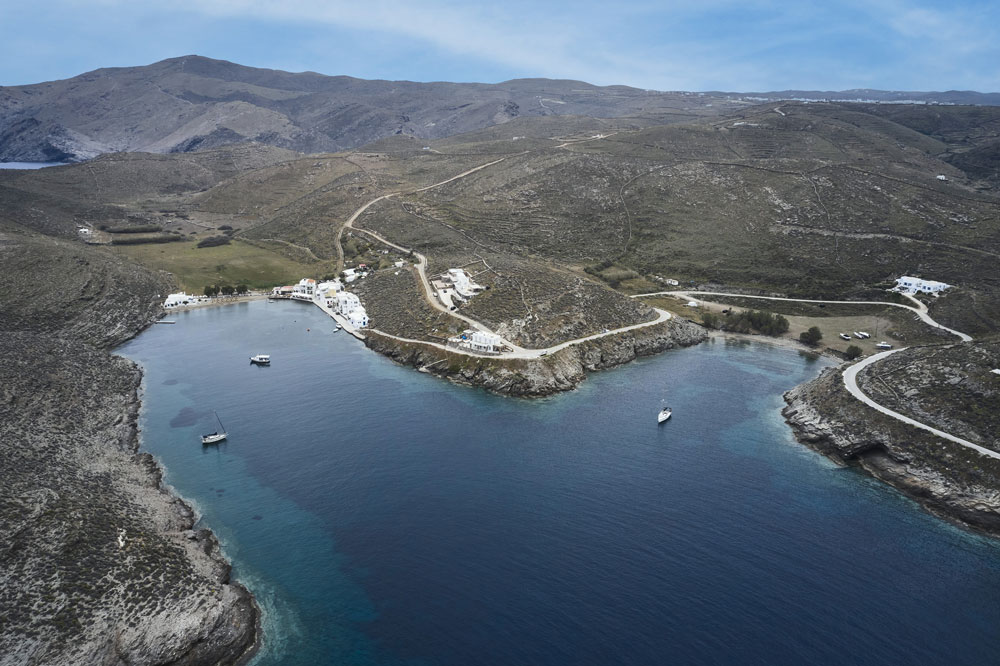
The island of Kythnos in Greece, which has evolved immensely in the past few years, is also called Thermia (or Thermiá), at least since the 12th century when it was referred to as the “Bishopric of Kea and Thermia”. This name is due to the presence of hot springs, which are located in the bay of Loutra. It is said that King Otto and Queen Amalia of Oldenburg enjoyed the baths of Kythnos.
Despite its small size, Kythnos records an extraordinary historical journey, spanning a period of a hundred centuries. Specifically, at Maroulas beach, the first human traces were discovered deep in prehistory, approximately 10,000 years ago (end of the Mesolithic Era, 8th millennium BC).
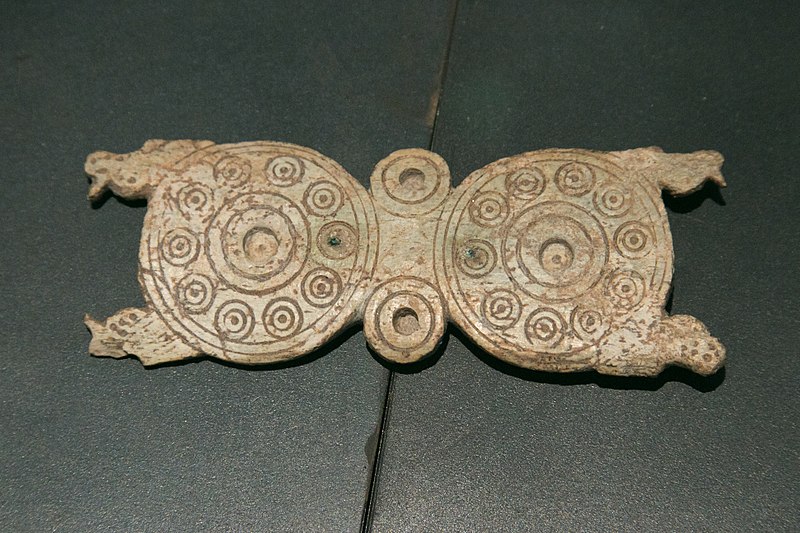
The next confirmed human activity on Kythnos is traceable to the early Bronze Age (3rd millennium BC), when the island, abundant with copper ores, attracted the attention of the copperworkers of that era. These people established settlements and built metallurgical furnaces, something that was repeated in modern times, with the intensive exploitation of iron ores.
The ancient name of Kythnos was Ophiussa, attributed to the abundance of snakes (ophis, in ancient Greek) found on its dry lands. The name Kythnos emerged in the 14th century BC when the island was colonized by the Dryopes from Euboea, led by Kythnos, a mythical son of the god Apollo.
During this era, the island mainly drew maritime and agricultural interest, traits that persisted throughout the subsequent Ancient Greek centuries. Merchant’s vessels entered its harbor (today’s Ovriokastro or Rigokastro), where the densely populated ancient capital of the island rapidly developed. Meanwhile, in the countryside, large herds of cattle and sheep grazed.
The products of Kythnos, such as wine, honey, and especially cheese, were highly sought after in the ancient markets. The development of Kythnos and the prosperity of its inhabitants during the ancient Greek times are reflected in the archaeological findings of its walls and temples, dedicated to Aphrodite, Apollo, and Demeter.
This small island’s historical prestige is also indicated by its participation in the Battle of Salamis, and in the references of Aristotle who praised its excellent democratic governance system.
The churches of Kythnos

In Kythnos, beyond the churches found within its two villages, there are about 130 chapels scattered throughout the island, serving as a testament to the religious faith of people from times past.
These centuries-old structures are lovingly maintained by the present-day locals, so annual festivals can be held to honor the saints. A cypress tree, often planted in the surrounding courtyard, adorns each chapel, signifying its presence from a distance to passers-by.
Often, these chapels profoundly mark the location to the point where they give their names to entire areas, like Ai-Sostis, Ai-Giannis, and Ai-Stefanos which are also the names of the ports of Kythnos.

Visitors to the island will have the opportunity to visit remarkable post-Byzantine churches in Chora and Dryopida. In Chora, significant architectural monuments with old icons are primarily the Holy Trinity, Saint Savvas, Theologos, Saint Nikolaos, and others.
In Dryopida, the church of Saint Mina with its carved wooden temple, bishop’s throne, and exquisite icons is noteworthy. The unique old church where frescoes are preserved, albeit damaged, is the Holy Trinity in the Venetian castle in Katakefalo.
Panagia Kanala
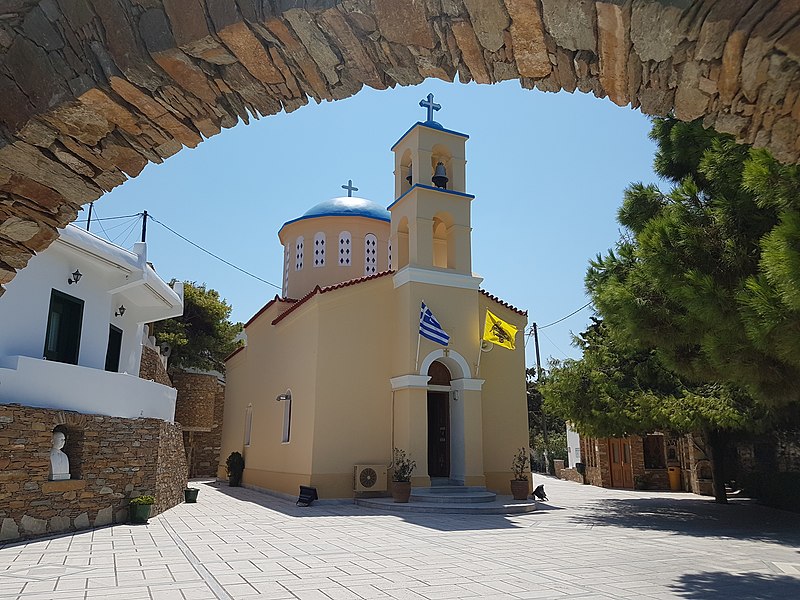
The church of Panagia Kanala, located in the eponymous coastal settlement of Kythnos, is situated in the southeastern part of the island and is one of the most significant pilgrimage sites in the Cyclades, as it is considered miraculous.
According to tradition, the icon of the Virgin Mary was found by fishermen in the narrow channel between Kythnos and Serifos. This is why it was named Panagia of the Canal (Kanala). It is an extraordinary work of the Cretan School, painted by the priest Emmanouil Skordilis in 1575.
Today, the icon is housed in a large church built in 1869. Every August 15th, a grand festival takes place at Panagia Kanala, featuring a procession and the reenactment of the finding of the Virgin Mary’s icon.
Around the church, in the island’s unique pine-clad area, a settlement has developed which offers restaurants, cafes, and rental rooms, while the bays of Megali Ammos, Ammoudaki, and Antonides stretch out nearby.
One of the most Instagram-able Greek beaches
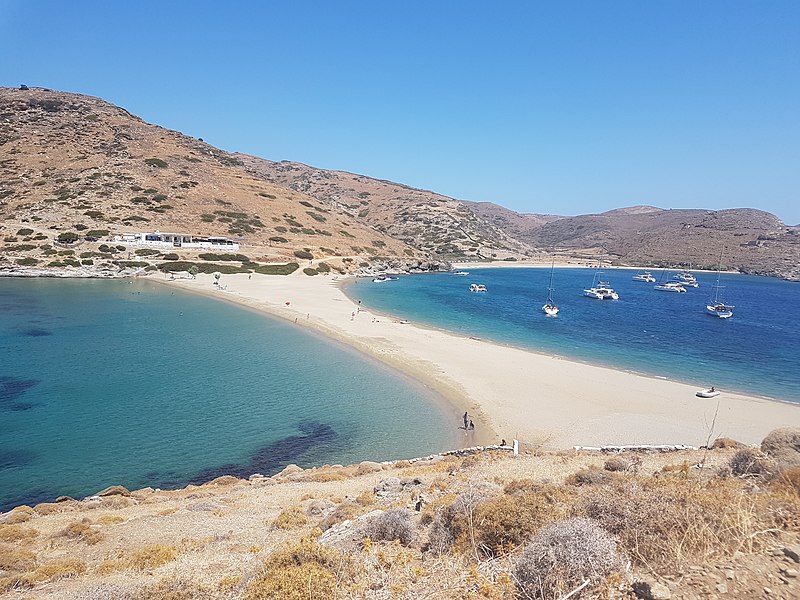
Kolona Beach in Kythnos is perhaps the most famous of all the island’s beaches. It is located in the bay of the same name, in the northwest of the island, north of the port of Merichas, and opposite the equally beautiful Apokrousi beach. After Apokrousi, through a relatively difficult dirt road, you can approach Kolona Beach. It’s a bit tough but the beauty and uniqueness of the beach will reward you.
Kolona Beach is unique mainly due to its geomorphological peculiarity. Essentially, it is a sandy beach, approximately 240 meters long, which connects the island of Kythnos to the islet of Agios Loukas. This strip of sandy beach that connects the two landforms resembles a column, hence its name. The sea surrounds both sides of the sandy beach, thus we have two beaches in one and an exceptional and unique view!
With its transparent, azure waters and thick, golden sand, Kolona Beach offers the ideal environment to enjoy the sea and swim in its crystal clear waters, while being surrounded by this impressive landscape. Its location provides protection from the wind on both sides.
The Katafyki Cave

The Katafyki cave is one of the most significant and impressive sights on the island, uniquely combining natural and human-made elements. It is located in the center of the island, at the southern end of the traditional settlement of Dryopida, in the area known as Fyres.
It is an underground space, at an altitude of 190 meters above sea level, consisting of a large natural cave and artificial mine shafts. Visitors can easily reach it through the picturesque alleyways of Dryopida.
The Thermia
Kythnos was named “The Thermia”, a name that was born because of the healing hot water that flows from the warm springs. Now, nobody uses that name, and the island is called Kythnos.
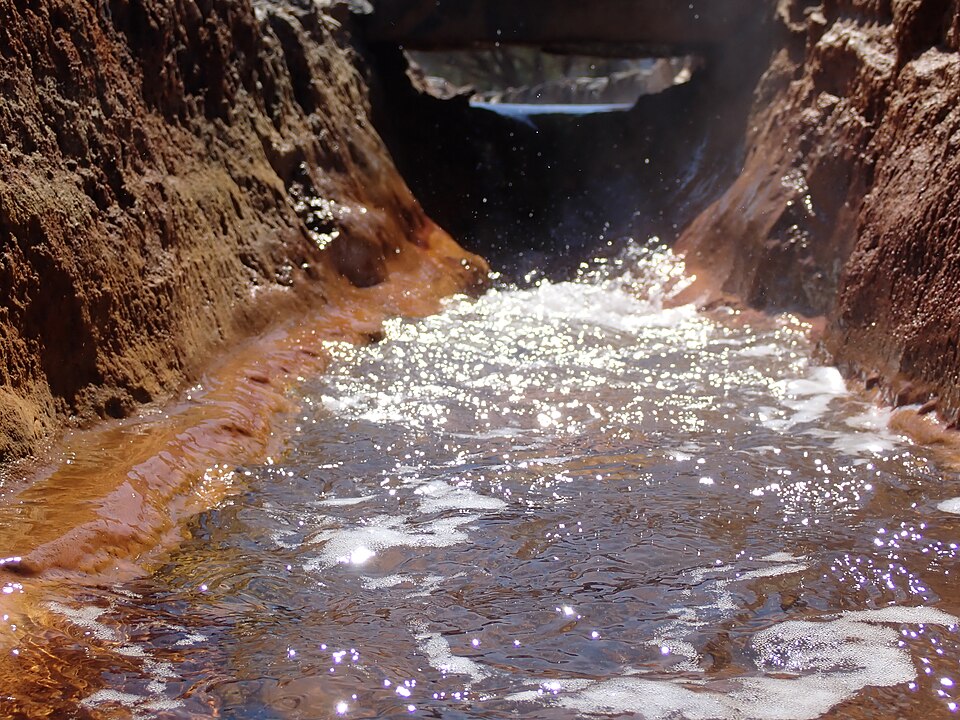
The thermal springs of Kythnos, affectionately dubbed “The Spa of the Cyclades,” are a testament to the island’s geothermal activity. Nestled amidst the island’s rugged beauty is Loutra, its most famous hot spring destination, with its two major thermal springs – the springs of Agioi Anargyroi and the springs of Kakavos. These natural wonders are a focal point of the island’s allure, offering visitors a unique, therapeutic experience amidst the picturesque Greek scenery.
The Loutra thermal springs are composed of two primary sources. The first, known as the Agioi Anargyroi spring, is located within the premises of a state-owned spa facility that’s no longer operational. However, the spring itself continues to flow, gushing out hot, mineral-rich water at a temperature of approximately 52 degrees Celsius.
This water is believed to be particularly beneficial for rheumatic, dermatological, gynecological, and respiratory conditions. Visitors often find themselves lounging in the small pool where the spring water collects, soaking in its healing properties under the open sky.
Nestled in the northeastern coast of Kythnos, the Loutra thermal springs are a cornerstone of the island’s wellness tourism. Loutra, meaning ‘baths’ in Greek, has been a spa town since Ottoman times, and its thermal springs are renowned for their therapeutic properties.
Whatever its name, either The Thermia or Kythnos, the island is a hidden gem waiting to be discovered by the world. Mark our words, Kythnos will be the hottest destination in the coming years. So try to enjoy it now, in its virgin state.
Lately, more and more people are discovering this paradise with its 92 beaches, crystal blue waters, the hot springs, the best honey in the world, and the kappari (caper) that is of exceptional quality.
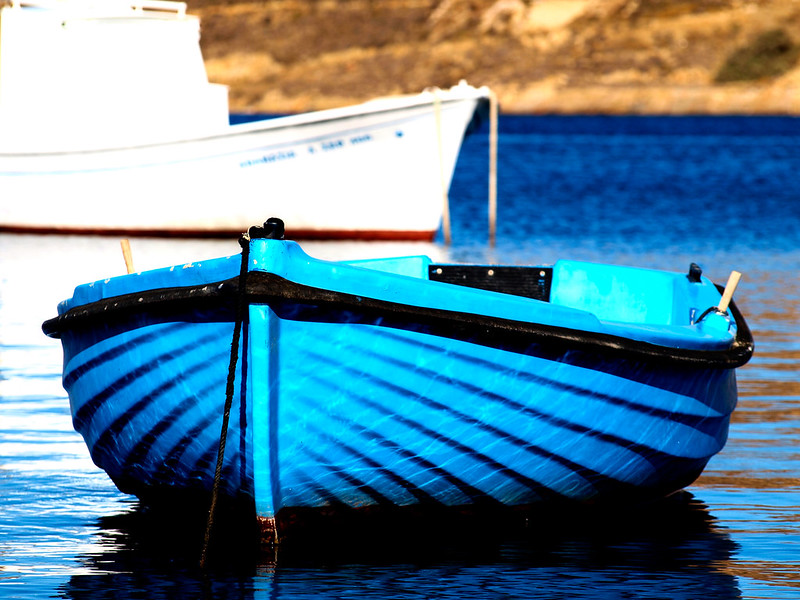
During your trip to Kythnos, you can taste honey that is beyond even the best you have ever tasted, dive into the warm waters and walk on the golden sand, take selfies on Kolona beach, and visit Panagia Kanala as a pilgrim.
You can go hiking and stargazing since Kythnos has no light pollution and so offers an excellent destination to watch the stars and the night sky. You can taste the magnificent cheese and the fresh, tasty seafood of the island and sink your body in the improvised pool that the locals have created where the hot springs of Loutra flow to the sea.
There, you can enjoy one of the most impressive sunsets you have ever seen. Leaving the island, you will leave a piece of you there; you must go back and claim it because Kythnos will steal your heart.
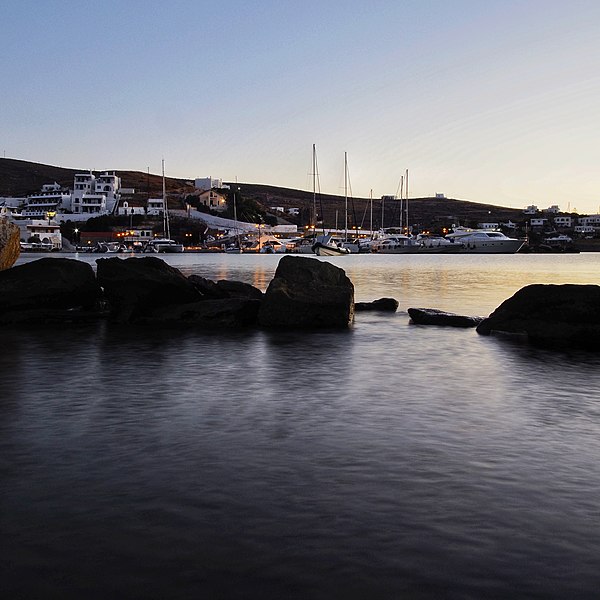
In the area of Loutra, high above the Loutra Bay and with a panoramic view, there is a new addition, amongst the developments that happen all around the island, to the hospitable settlements of Kythnos. A stone’s throw from Athens, the Thermia Suites is a sanctuary of elegance and comfort.

Totally embedded into the environment, with its minimalistic Cycladic architecture, a 3 minutes walk from the thermal springs, and a 6 minutes walk from all the cafes and restaurants at the Loutra marina, The Thermia Suites offers a perfect ticket to relaxation and tranquility.
Sitting on your own veranda at night and enjoying the stars, the super yachts that tend to prefer the Loutra Bay as their secret spot, and the cicadas, with a glass of wine or one of the ready-made cocktails that you can find in your room’s fridge from a well-known Athenian bar, will reveal to you the truth behind the reason why people all around the world are dreaming, as you read this article, of summer in Greece.
See all the latest news from Greece and the world at Greekreporter.com. Contact our newsroom to report an update or send your story, photos and videos. Follow GR on Google News and subscribe here to our daily email!



